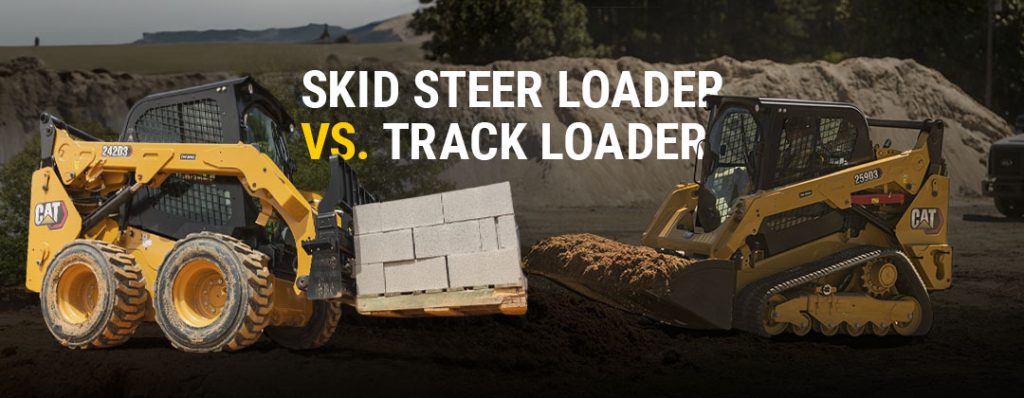
Skid steers and compact track loaders may seem similar on the outside, but they are very different tools in terms of what they can do. Knowing which one is the right choice for your job or fleet is vital. This guide will look at each vehicle on its own and then compare them to help you make the right choice for your schedule, fleet and team.
Before comparing these two machines, you must know what each can do.
A skid steer, otherwise known as a skid loader or wheel loader, is a compact piece of machinery. The skid steer is used for various tasks, including digging. This versatile compact vehicle is lightweight, making it easy to maneuver. It also has different arms that can be used for landscaping and construction work.
Skid steers have four wheels and a unique driving mechanism. The front and back axles are designed to synchronize with each other’s movements automatically. Drivers can still move each wheel separately on the other side of the vehicle. The wheels stay in a straight and fixed alignment and will not turn.
To turn your skid steer, you need to increase the speed of the wheels on only one side. This makes the wheels drag or skid along the ground while the machine rotates. This is where the skid steer gets its name.
These are the most common tasks skid steers can be used for and the extensions they use to accomplish them:
A compact track loader is like a skid steer but moves on two tracks parallel to each other rather than having four wheels. They are roughly the same size as a skid steer and can do the same functions. One key difference is that a compact track loader is far better at moving on uneven and difficult terrain.
Compact track loaders are better for more specific uses than skid steers since they can more easily navigate through different terrains. However, they don’t have the same level of maneuverability as a skid steer because they lack zero-radius turning capabilities.
These machines are used for a wide variety of jobs and situations, including:
Each vehicle has its own set of advantages and potential disadvantages to consider. To compare them fairly, consider both the positives and drawbacks of each vehicle:
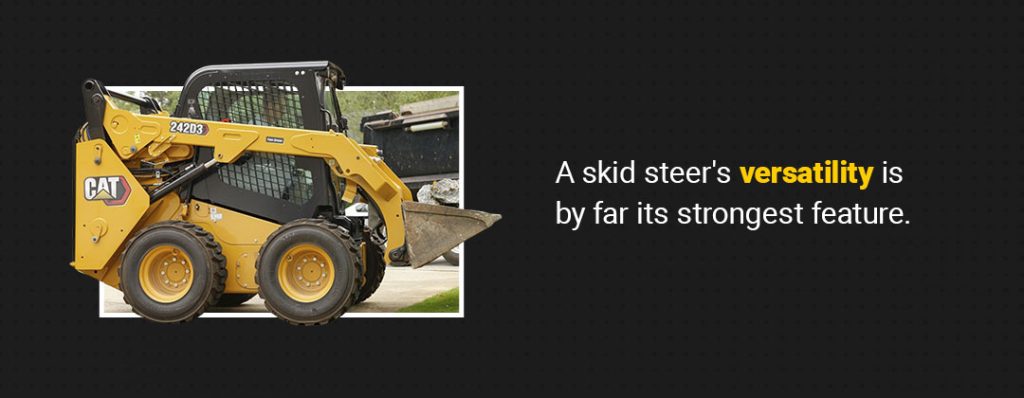
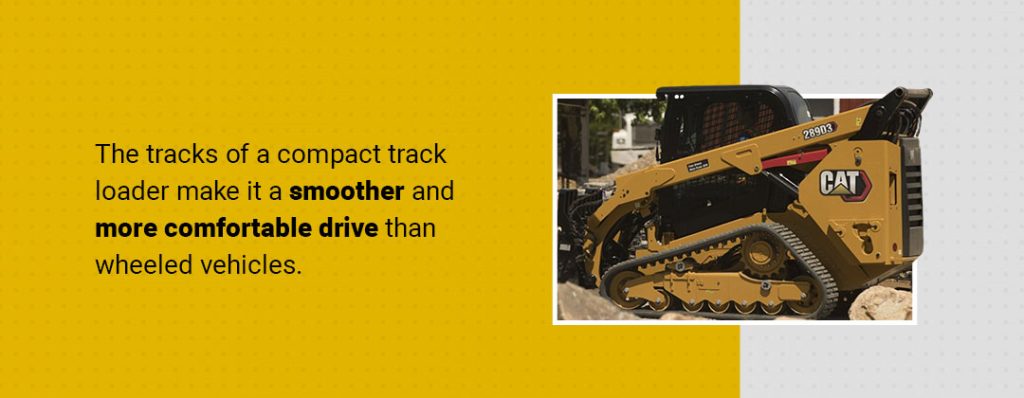
Now that you understand what each machine does well and its disadvantages, you can more easily compare them. From what they can do better to the difference in maintenance costs, this is how skid steers compare against compact track loaders:
Skid steers are light in weight and have a high center of gravity compared to compact track loaders. Larger skid steers can do a lot of heavy lifting and more demanding tasks even though they weigh less. However, they have less traction, making it harder for them to move objects with a lot of resistance.
The weight distribution on a track loader increases the amount of ground it touches. This gives them a higher lifting capacity and the ability to move heavier things without the risk of slipping. Compact track loaders generally have more horsepower than skid steers, making them a better option for jobs that require more power, like dozing and clearing.
Skid steers are the best choice for working on hard and flat surfaces, such as asphalt, concrete, roads and any other developed surface. Wheels are designed to work better on these surfaces without damaging the tires or the surface being driven on. However, tires struggle to get the right grip in snowy, slippery, muddy and wet conditions.
The compact track loader is the way to go when it comes to less manageable and more difficult terrain. Undeveloped ground and uneven terrain are far easier to work on with tracks. A vehicle like a skid steer will sink in loose sand and muddy ground, but the tracks of a compact track loader will keep it stable. Tracks are better at evenly distributing the machine’s weight, providing better traction and preventing the compact track loader from slipping.
Skid steers are well-known for their excellent turning abilities. They can handle sharp turns easily and almost rotate in place. They are ideal when working in small places or sites with tight corners. A skid steer makes an excellent choice for crowded job sites and smaller workspaces.
Track loaders are less likely to do as well in tight spaces. They have fixed axles and similar turning abilities as skid steers, but they are slower and larger. This makes it harder for them to perform tight turns quickly and smoothly.
The skid steer is a fast-moving machine. They are lightweight, and their tires allow them to move faster than the tracks of compact track loaders. Skid steers are especially faster on flat surfaces. Turning is easier and can be done faster with a skid steer.
Track loaders are slower than skid steers. As a result, they are less well-suited for tasks that require going back and forth from one spot to another a lot. This is not much of a problem for longer projects but is something to remember when working on a tight schedule. They are faster and more efficient on uneven and muddy terrain than skid steers.
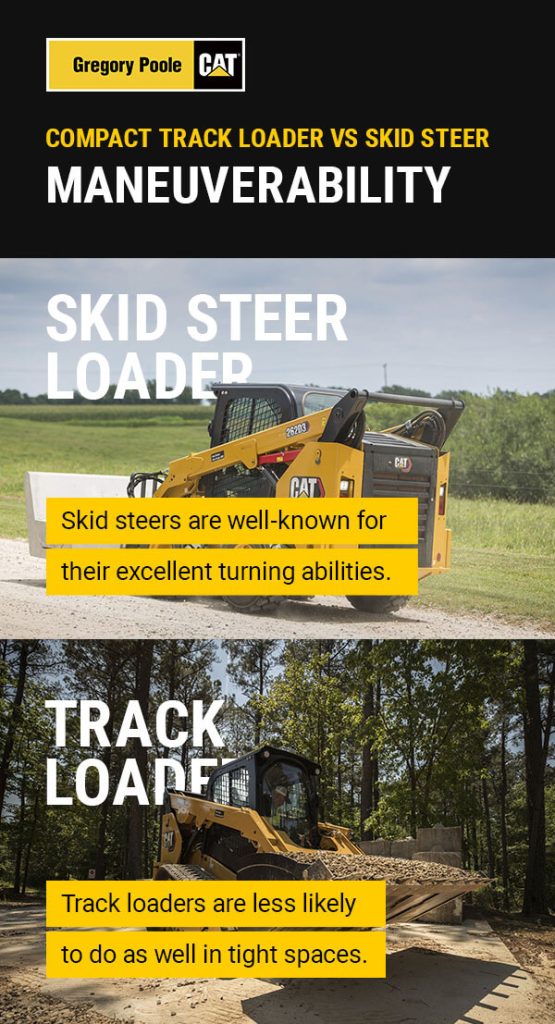
A machine’s functionality is key, but its ability to help with site cleanup after a job is done is a great thing to pay attention to. The ability to clean up a job site quickly can make a noticeable difference in your schedule. Skid steers are better for cleaning up job sites on concrete and other hard surfaces, making them a smart addition to your cleanup work, especially for jobs in urban areas.
Track loaders do less damage to soft surfaces and grass. Their flat tracks and even weight distribution means they won’t tear up the ground and leave holes in the soil. While skid steers are efficient and more cost-effective for smaller jobs and flat surfaces, compact track loaders are better for cleaning up worksites on soft or uneven ground.
If you want a machine that’s easy and cost-effective to maintain, you should get a skid steer. They need maintenance less frequently, and their parts are easier to replace if they break. The wheels give you easy access to the undercarriage, making cleaning and maintaining the machine easy.
The tracks on a compact track loader cover up almost the entire undercarriage. This means cleaning and maintaining it takes more time and effort. For once-off projects and simple tasks, this can be a daunting disadvantage. This is one of the reasons why track loaders are more commonly rented than purchased. Avoiding maintenance time and energy can reduce productivity, especially when it needs to be done carefully and frequently.
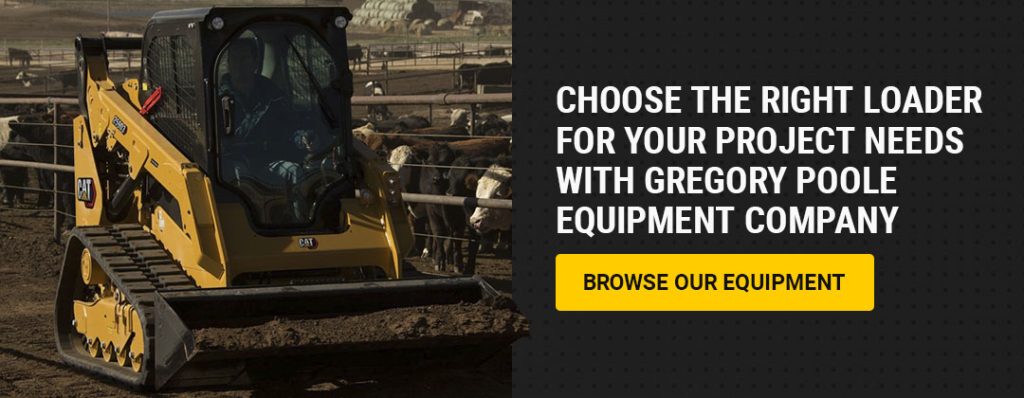
The biggest differences between skid steers and compact track loaders are their wheels and the terrain they are optimized to work on. The differences in their speed, strength and maintenance are also useful points to consider. Use this information to ensure you make the right choice for your job.
For more insights you can trust about construction equipment and vehicles, contact us at Gregory Poole Equipment Company. We offer personalized advice and provide premier Cat® equipment for purchase or rent. We offer an extensive range of new equipment to add to your fleet. You can also browse our rental models that are properly maintained and in top-notch working condition.